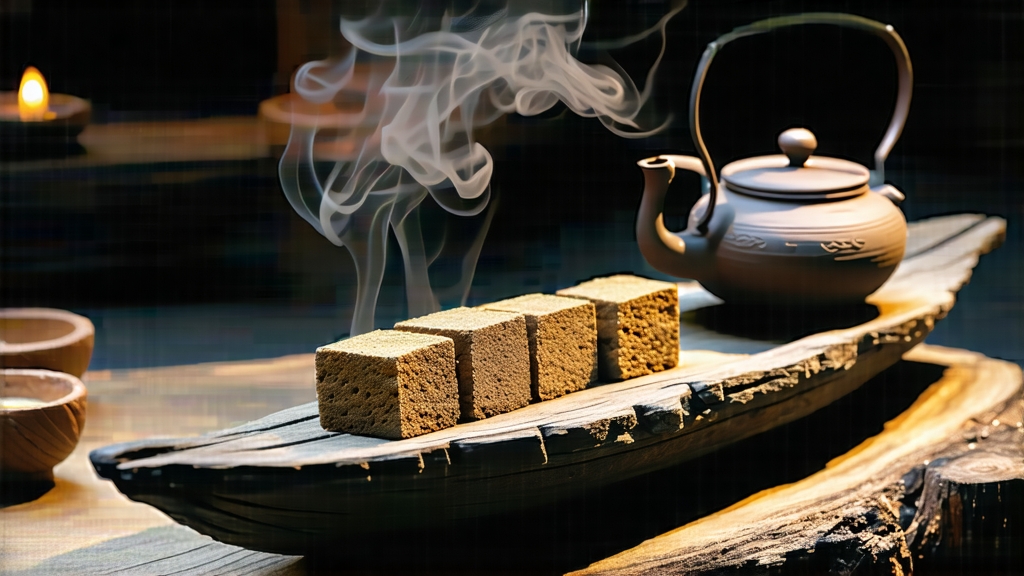
Liu Bao, literally “Six Forts,” is the quiet diplomat of China’s dark-tea family. While Pu-erh commands headlines, this cousin from the subtropical hills of Guangxi has spent four centuries smoothing its edges in bamboo baskets, ferrying along the same river routes that once carried emperors and opium. To meet Liu Bao is to taste the geology of southern China: laterite soils, monsoon humidity, and the camphor-wood barges that first taught it how to breathe.
History: From Border Garrison to Global Cup
The name memorializes six Qing-era military posts that guarded the trade corridor between Guangxi and Guangdong. In the late Ming, pressed tea leaves were already moving down the Xun River to Guangzhou’s foreign hongs; by the Qing, Liu Bao was ballasted in the hulls of junks bound for Hong Kong, then onward to Malaya and Borneo. Miners and dockworkers in Kuala Lumpur learned to boil it with rock sugar to fend off malaria; the British Straits Settlements recorded it as “black brick” in 1872 manifests. When the Malayan Emergency disrupted rubber estates in the 1950s, Guangxi state factories revived production specifically for Southeast Asian remittances, sealing the tea’s reputation as an overseas comfort rather than a domestic luxury. Only in the past decade has it circled back to Shanghai boutiques and Brooklyn cafés, rebranded as a probiotic elixir with vintage swagger.
Terroir and Leaf: Two Faces of the Same Plant
All authentic Liu Bao comes from the Yao and Han gardens that straddle the Tropic of Cancer between 200–800 m elevation. The indigenous cultivar, Camellia sinensis var. sinensis f. pubilimba, carries an extra down on the leaf underside, trapping humidity and encouraging the fungus Eurotium cristatum—later celebrated as “golden flowers” when it appears in Fu bricks, but here it remains an invisible backstage hand. Spring buds are small and purplish; autumn leaves grow broader, carrying more pectin that will translate into the tea’s signature thick liquor. Gardens interplant with cinnamon and longan trees, whose roots share mycorrhizal networks, adding a faint sweet-wood note impossible to replicate on monoculture farms.
Craft: The Rhythm of Pile, Basket, and Cave
After plucking, the leaves wither under shade nets for two hours—just long until the edges feel like suede. A 200 °C drum roast for three minutes kills green enzymes, but the pan is tilted steeply so leaves tumble rather than press, preserving stem integrity. Rolling is brief, 8–10 minutes, to keep cell breakage at 35 %, the sweet spot for later microbial dining. Then comes the defining act: wet piling, or wo dui, borrowed from 1970s Pu-erh but gentler. Leaves are sprayed with mineral-rich river water, stacked 70 cm high, and covered with jute. Every 48 hours a “turn” happens—workers shuffle the pile with bamboo rakes, aerating and redistributing moisture. Temperature is kept below 55 °C; five turns suffice, compared with Pu-erh’s eight or nine, yielding a lighter fermentation (30–40 % oxidation). After piling, the tea is not immediately pressed; instead it is sun-dried for one day, then steamed soft and packed into cylindrical bamboo baskets called long jars, 40–50 kg each. These baskets are moved into “tea caves”—actually decommissioned air-raid tunnels carved into the hills during the 1960s. At 85 % relative humidity and 22 °C the tea rests for a minimum of three years, during which slow secondary fermentation converts catechins into theaflavins and gallic acid, while Actinobacteria generate a unique methyl salicylate that later translates into the cooling, almost wintergreen finish detectable in aged lots.
Grades and Labels: Decoding the Basket
Liu Bao is sold both loose and compressed, but connoisseurs chase the basket-aged grades. Top-tier carries the provincial standard “GX/LY 2009” sticker and a red-ink chop on the bamboo: first number = year of piling, second = garden code. “Special Grade” (teji) uses one bud-two leaves; “First Grade” allows 20 % stems, adding a honey note. “Old Tree” (laoshu) is a recent marketing tag for leaves picked from unpruned